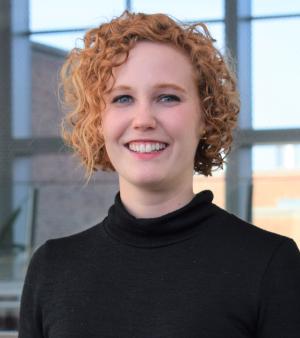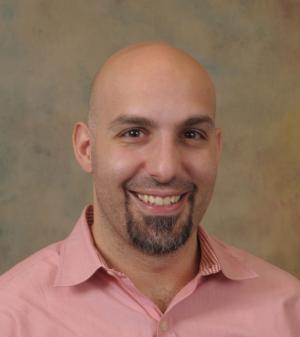Colleagues: Recently Tenured
ADRIENNE CAMPBELL-WASHBURN, PH.D., NHLBI
Senior Investigator, Laboratory of Imaging Technology, Cardiovascular Branch, NHLBI

Education: University of Western Ontario, London, Ontario, Canada (B.Sc. in honors physics); University College London, London (Ph.D. in medical physics)
Training: Postdoctoral visiting fellow, Laboratory of Cardiovascular Interventions, NHLBI (2013–2016)
Came to NIH: In 2013 as a postdoc; became a staff scientist in 2016; became a Stadtman tenure-track investigator in 2020, NHLBI
Outside interests: Traveling; hiking; dance; family
Website: https://irp.nih.gov/pi/adrienne-campbell-washburn
Research interests: My lab aims to develop magnetic resonance imaging (MRI) methodology for cardiac imaging, pulmonary imaging, and MRI-guided cardiac catheterization procedures. We develop rapid image acquisition methods and advanced image computation methods that integrate into the clinical environment for new MRI applications that are efficient and patient-friendly (PMID: 38501940; 32291845; 38469944). Moreover, we strive to translate these techniques for clinical impact through patient assessment, open-source software development, and partnerships with industry.
Recently, my lab pioneered a high-performance lower-field MRI system, which combines modern hardware and software with a lower magnetic field strength (PMID: 31573398). Conceptually, this system shifts the burden of MRI from the magnetic field hardware, which is expensive, to algorithms, software, and computing, which are inexpensive. This system has been commercialized as a more cost-effective and accessible imaging technology, and we have demonstrated its value for cardiac and pulmonary imaging applications (PMID: 34250492; 34652290; 34023254; 32423456).
Future directions: In the future, my goals are to expand on our work to develop smarter patient-tailored imaging methods, establish 0.55T as the standard for assessing cardiopulmonary interactions, improve functional lung MRI, translate methods outside of NIH, and improve the overall accessibility and useability of cardiac imaging.

Read more about Campbell-Washburn’s work on the “I Am Intramural Blog.”
LEAH M. COOK, PH.D., NCI
Senior Investigator, Cancer Innovation Laboratory, NCI-CCR

Education: University of Alabama at Birmingham (B.S. and M.S. in biology; Ph.D. in molecular and cellular pathology)
Training: Postdoctoral fellowship at Moffitt Cancer Center, Tampa, Florida (2012–2017) in bone metastasis of prostate cancer and transforming growth factor beta (TGF-beta) signaling in cancer-induced bone disease
Before coming to NIH: Associate professor with tenure, University of Nebraska Medical Center, Omaha, Nebraska (2017–2024)
Came to NIH: In March 2024 as a senior investigator, NCI
Outside interests: Reading; any outdoor water activities like kayaking; zombie movies and shows
Website: https://ccr.cancer.gov/staff-directory/leah-m-cook
Research interests: Bone metastatic prostate cancer (BM-PCa) is the deadliest aspect of prostate cancer and is currently incurable. In bone, PCa cells induce excessive bone breakdown and abnormal bone formation resulting in the release of bone-derived growth factors, such as transforming growth factor beta (TGF-beta), which drive tumor growth. PCa cells rely heavily on interactions with bone-resident cells to survive and proliferate in bone. The most abundant immune cell in bone are neutrophils. Neutrophils are “first-responder” innate immune cells that mount a rapid response during inflammation and infections that is resolved by macrophages. My lab previously discovered a key phenomenon that bone marrow neutrophils are initially protective against BM-PCa that has disseminated into the bone compartment (PMID: 32114681). However, we found that the tumor inevitably becomes resistant to neutrophil antitumor responses and suppresses neutrophil function, a finding that can be leveraged for the development of novel immunotherapeutic treatment options. We have identified several mechanisms associated with tumor-neutrophil interactions that contribute to prostate tumor evasion of neutrophil antitumor immune response, including PCa STAT5 expression, reactive oxygen species (ROS), and androgen therapy (PMID: 32114681, 35604506, and 37940068, respectively). We are primarily focused on the intersection between bone metastatic prostate cancer, tumor-associated neutrophils, and prostate cancer-induced bone disease. Our main goal is to identify novel immunotherapeutic targets for treating and curing bone metastatic prostate cancer.
Future directions: Our next five projects, described in detail on my lab website, aim to understand:
- The role of STAT5 in PCa progression and response to neutrophils
- The role of Nox2, ROS, and redox metabolism in BM-PCa
- Androgen-mediated regulation of neutrophils
- How neutrophils kill prostate cancer cells
- IL-8 regulation of mesenchymal stem cells and PCa-induced osteogenesis
MICHAEL MICHAELIDES, PH.D., NIDA
Senior Investigator and Chief, Biobehavioral Imaging and Molecular Neuropsychopharmacology Section, NIDA

Education: Stony Brook University, Stony Brook, New York (B.A. in economics and Ph.D. in integrative neuroscience)
Training: Postdoctoral fellow, Icahn School of Medicine at Mount Sinai, New York (2010–2015)
Came to NIH: In 2015 as a tenure-track investigator, NIDA
Outside interests: Traveling with family; basketball; weightlifting; cooking; gardening
Website: https://irp.nih.gov/pi/mike-michaelides
Research interests: My laboratory combines techniques spanning behavioral neuroscience, in vitro and in vivo pharmacology, imaging, molecular and synthetic biology, and neuromodulation to study the mechanistic, molecular, and circuit basis of mood and motivational disorders. My laboratory has dissected the mechanism of action of popular medications with known abuse liability (for example, ketamine and methadone) (PMID: 33859356; 35768639; 38291050; 38145984). We have also developed novel imaging agents for positron-emission tomography (PMID: 35999424) and technologies for combined brain imaging and neuromodulation (PMID: 28774929; 30872534; 33895327; 31604917; 37494470). Our imaging work emphasizes state-of-the-art, noninvasive whole-brain molecular approaches in behaving subjects (PMID: 33549570).
Future directions: Ongoing and future work includes 1) assessing the mechanistic basis and promise for the use of ketamine as a treatment for addiction; 2) developing novel opioid-based pain medications with lower adverse effect profiles than existing opioid medications; 3) developing novel pharmacotherapies for addiction; and 4) developing novel translational imaging and neuromodulation technologies.
ALEXANDER SODT, PH.D., NICHD
Senior Investigator, Unit on Membrane Chemical Physics, NICHD

Education: University of Washington, Seattle (B.S. in physics and chemistry); University of California at Berkeley (Ph.D. in chemistry)
Training: Postdoctoral fellow in biophysics, University of California at Berkeley (2007–2009), postdoctoral fellow in biophysics, NHLBI (2009–2015)
Came to NIH: In 2009 as a postdoctoral fellow, NHLBI; in 2016 became a Stadtman tenure-track investigator
Outside interests: Spending time with my family; running; woodworking; tennis
Website: https://irp.nih.gov/pi/alexander-sodt
Research interests: My lab applies computational techniques to understand how lipid chemical structure determines the mechanics of biological membranes. Membrane mechanics refers to a model of the response of the membrane to an external force, such as from a protein. What I find particularly exciting about a biological lipid membrane is its dual role as a thin but very effective surface barrier, and its in-plane liquid nature that allows the hundreds of different lipids of the cell to get where they need to be. This dynamic liquid aspect makes membranes difficult to study experimentally, but, given their importance, makes them a prime target for molecular-scale simulation.
Recently, my lab has developed methodology for interpreting how small differences in lipid chemical structure change membrane mechanics (PMID: 34005918). In particular, our modeling can resolve impactful differences between cholesterol precursors, including those related to developmental disease. Additionally, with our lab’s publicly available software we have built intermediates in membrane reshaping (fusion or fission pores) that show, counterintuitively, how a sterol that stiffens membranes can drive a reshaping process through its dynamic lateral redistribution (PMID: 36588341).
Future directions: With the ability to quantify the effects of small changes in lipid chemical structure, we are now applying these tools to answer the question of “Why do we have the lipids we have?” from the standpoint of lipid mechanics. I am particularly interested in the roles of lipids in viral entry into the cytoplasm, and how immune system factors like IFITM3 may shift the energetics of membrane-mechanical barriers to viral fusion.
This page was last updated on Tuesday, December 3, 2024
